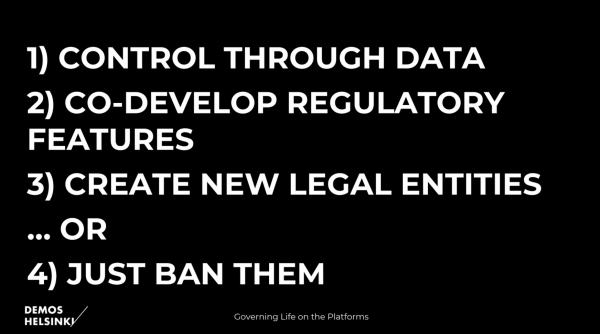Governments around the world are muddling through the first decades of the 21st Century. People’s needs are diversifying, and addressing them is becoming increasingly challenging in the existing interconnected and complex systems. Multiplying wicked problems such as climate change, pandemics, poverty and social injustices further complicate public governance. At the…
Governments around the world are muddling through the first decades of the 21st Century. People’s needs are diversifying, and addressing them is becoming increasingly challenging in the existing interconnected and complex systems. Multiplying wicked problems such as climate change, pandemics, poverty and social injustices further complicate public governance.
At the Good Governance afternoon talks at Demos Helsinki on January, 18 civil servants from across Europe gathered to discuss these issues. Demos Helsinki’s researchers and specialists, joined by special guest professor Dr. Ramia Mazé from Aalto University, gave talks on how to renew public governance through up-to-date views, processes and tools.
What does a civil servant need in order to improve their way of working in 2018? Here are our top takeaways from the Good Governance talks:
1. Co-create common good.
Having different kinds of people on board in the policy development process and bringing them together to create a unified vision is easier said than done. When you involve stakeholders and citizens in order to find the best possible solution, that chosen solution is likely to be more widely accepted than if you had limited the discussions to only a select few. Digitalisation enables radically improved ways of participation (see for example how Obama’s Administration utilised IdeaScale). Only a fraction of the potential of these measures is being utilised.
2. Maintain a focus on the long-term.
Even though responsiveness and fast measures are needed and appreciated by voters, short-termism is a problem in all policy sectors. Try to exercise foresight and use backcasting as a strategy tool: set a goal in the future, and think backwards on what kind of measures are needed to make it reality. Re-define the goal and the measures based on experiments and data gathered along the way.
3. Life happens on platforms. Govern them!
The way people come together and create value is changing, as new forms of business and human contact emerge through global digital platforms such as Amazon, Etsy, Facebook and Uber. To ensure that people maintain a level of control when dealing with these economic powerhouses, we need leverage through public governance. For example, you can require these businesses to share their data, or to co-develop their regulatory features with the government, to remain legal. And if push comes to shove, there are stronger measures you can take.
4. Try employing design closer to agenda setting, not only as an adjustment tool.
During the last decade, public administrations have learned to understand design as a tool for making public services or policy implementation more human-centric. However, the real potential of design might lie in the “upstream of policy making”. This means that policies are designed human-centrically: by framing the problem together with stakeholders and breaking barriers between governmental silos. And most importantly, by involving experiments and citizen-experience in policy making from the beginning of the process.
5. Think beyond checklists like this.
Even though governance can be renewed through new ideas and tools, there is no one-size-fits-all approach to do the trick. Change takes time and learning. In Ramia Mazé’s words, it starts with you – expand your own mind and think beyond the silos, the limits and the boxes of your own work.
Innovation lies with open minds
The European Commission guests, members and facilitators of the Public Administration and Governance Network, gave good feedback on the thoughts presented.
Vladimír Kváča, a facilitator of the network, found many of the approaches inspiring. He also identified a real-life example from his country, the Czech Republic, that was closely related to Ramia Mazé’s presentation on design in policy making. Kváča described how librarians at the academic team of Division of Information and Library Studies at the Masaryk University embraced human centered approaches. First the team used the methods to develop better libraries, and then expanding to helping the entire municipality of Brno with policy design processes on an ordinary basis.
– Innovation is spreading and it can pop up in unexpected places, Kváča said.
We asked Kváča about the most important characters of a civil servant today.
– Being a superhero?, he laughed.
– You have to be open-minded and have good communication skills. Many problems civil servants face today are very complex and interconnected. Developing functional solutions is based on networks and hearing out different stakeholders, which is very difficult to do if you stay within the hierarchical system.

How to govern platforms? 4 different directions, explained by Dr. Veikko Eranti, Demos Helsinki
The way to go forward
Mina Shoylekova from the European Commission recognized the diversity of countries as a challenge in terms of unified advice, but was positive about the new ideas.
– Innovation shouldn’t become a policy in itself, but it should be an approach through which governance and institutions work, and a part of what they deliver to society.
According to Pedro das Neves Moreira from the European Commission, the ability to execute in terms of renewing governance already exists.
– It is now a question of putting together the different tools and elements in a proper framework and about the continuous political commitment to make it happen at EU scale, he said.
The Good Governance presentations of Demos Helsinki can be downloaded here.
